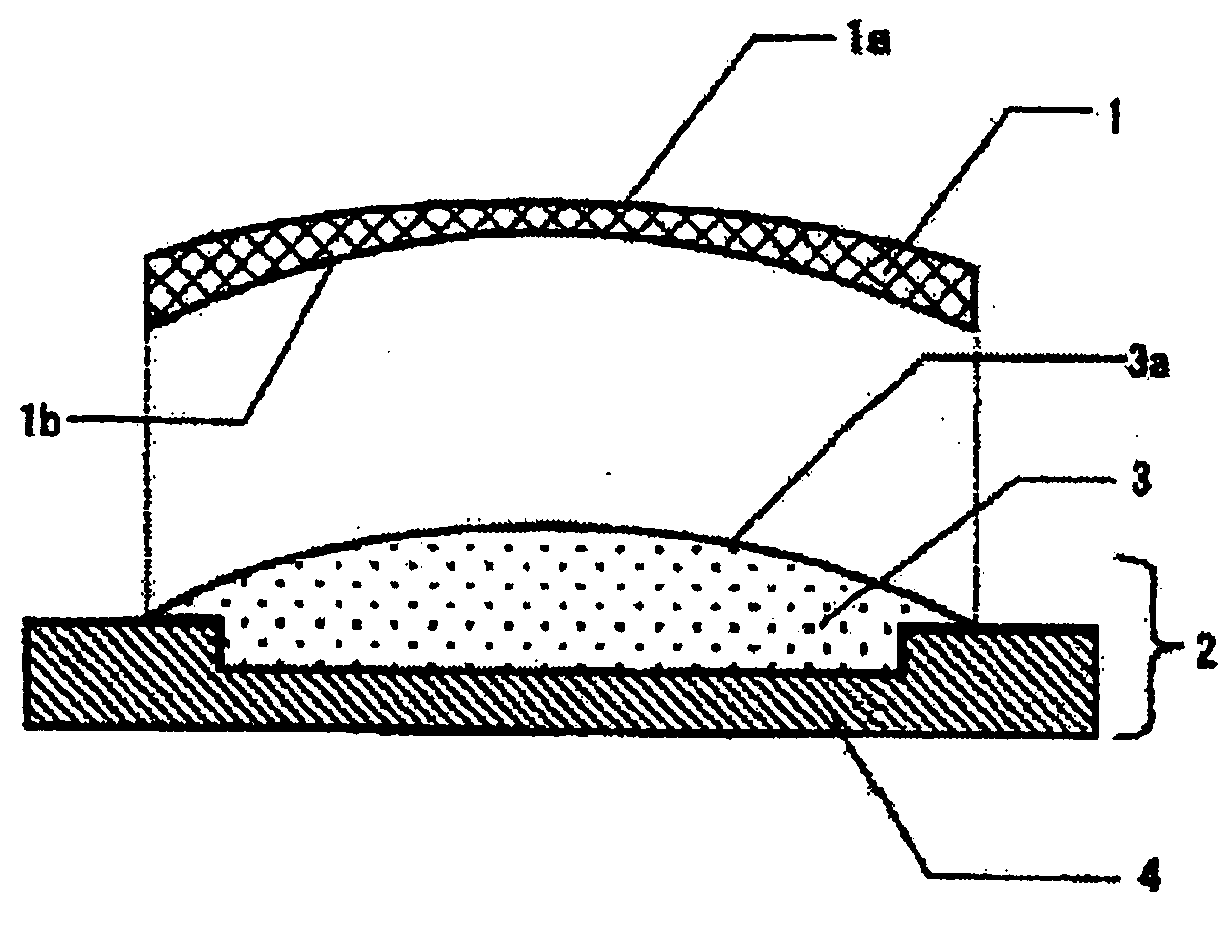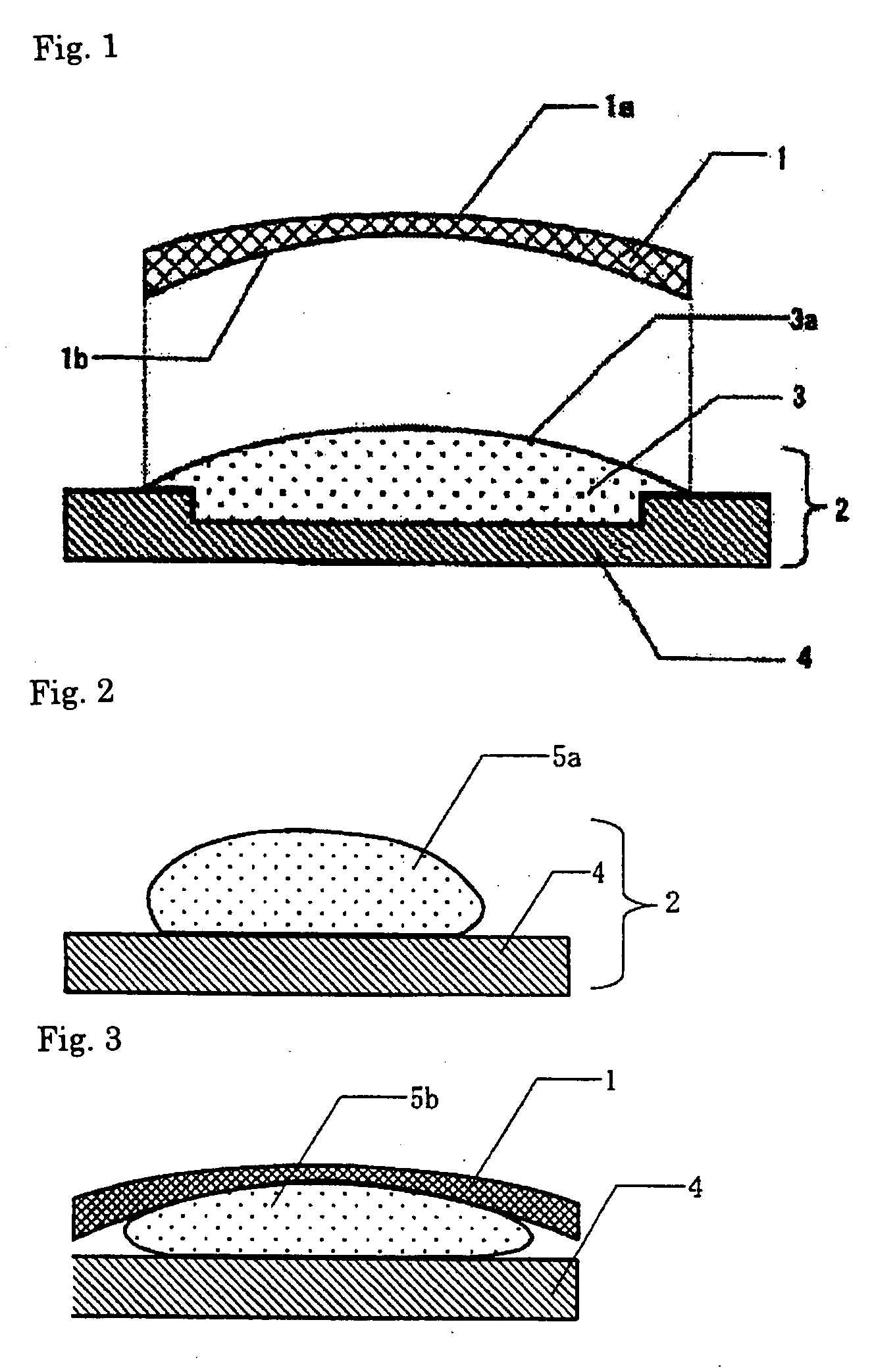Process for producing coated plastic lenses, and lens holder
a technology of coating and lens, applied in the direction of coating, mounting, instruments, etc., can solve the problems of deformation, inability to withstand stress, and difficulty in sufficiently cured coating agent applied on the surface of plastic lens without deforming the plastic lens, etc., to achieve high productivity, reduce cost and size of production apparatus
- Summary
- Abstract
- Description
- Claims
- Application Information
AI Technical Summary
Benefits of technology
Problems solved by technology
Method used
Image
Examples
example 1
[0068]A denture base silicone soft lining material (tradename: SOFRELINER MEDIUM SOFT manufactured by Tokuyama Dental Corporation) was applied to a space between the back surface of a thiourethane resin plastic lens 1 and a lens holder body 4 made of an acetal resin as shown in FIG. 1. The lining material was allowed to stand at room temperature for one hour to cure. Subsequently, the cured soft lining material (silicone rubber article) was removed from the lens holder body. The extra material protruding on the periphery was cut off to obtain a silicone rubber lens-contact member 3. The lens-contact member 3 was fixed to the lens holder body 4 to produce a lens holder 2.
[0069]A thiourethane resin lens substrate (central thickness: 1 mm, peripheral thickness: 7 mm) having an identical configuration of the back surface to the lens substrate used in the production of the lens-contact member 3 was pretreated by soaking it in a 10% aqueous alkaline solution at 60° C. for 5 minutes. The l...
examples 2 to 7
[0093]A sample was prepared and evaluated in the same manner as in Example 1, except that the lens had a configuration (central thickness / peripheral thickness) as shown in Table 1 and the irradiation conditions were as shown in Table 1. The results are shown in Table 1.
example 8
[0095]A spherically-shaped polybutene-based non-drying putty 5a (NEOSEALER MS-N12 manufactured by MATSUMURA OIL CHEMICAL) was placed on a lens holder body 4 made of an acetal resin as shown in FIG. 2. The putty was lightly pressed against the substrate. Consequently, a lens holder 2 was fabricated.
[0096]A thiourethane resin lens substrate 1 (central thickness: 1 mm, peripheral thickness: 7 mm) was pretreated by soaking it in a 10% aqueous alkaline solution at 60° C. for 5 minutes. The lens substrate 1 was washed with pure water and was dried. The photocurable coating agent described in Example 1 was applied to the lens substrate to form an uncured coating. Spin coater 1H-DX2 manufactured by MIKASA (600 rpm) was used for forming coating, and the uncured coating formed was 40 μm in thickness.
[0097]The lens coated with the photocurable coating agent was pressed against the non-drying putty on the lens holder, with the surface (convex surface) coated with the uncured coating upward, as ...
PUM
| Property | Measurement | Unit |
|---|---|---|
| thickness | aaaaa | aaaaa |
| surface temperature | aaaaa | aaaaa |
| surface temperature | aaaaa | aaaaa |
Abstract
Description
Claims
Application Information
 Login to View More
Login to View More - R&D
- Intellectual Property
- Life Sciences
- Materials
- Tech Scout
- Unparalleled Data Quality
- Higher Quality Content
- 60% Fewer Hallucinations
Browse by: Latest US Patents, China's latest patents, Technical Efficacy Thesaurus, Application Domain, Technology Topic, Popular Technical Reports.
© 2025 PatSnap. All rights reserved.Legal|Privacy policy|Modern Slavery Act Transparency Statement|Sitemap|About US| Contact US: help@patsnap.com



